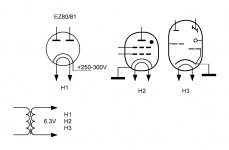I read what "each tube have floating cathodes should use independent heater".
I do not understand why. For example, I use 3 tubes outside of audio path signal, one have 250V cathode potential (EZ80 rectifier), other cathodes connected to GND (EM800 indicator and TG1 thyratrone).
Each tube maximum cathode to filament voltage:
EZ80 500V
TG1 0 to -50V
EM800 +/- 100V
So, in that case I can connect all 3 filaments to one supply.
Is it correct, or should I connect middle of winding to ground, because EZ80 may give some positive voltage on heater(?), but it is not possible for thyratrone.
I do not understand why. For example, I use 3 tubes outside of audio path signal, one have 250V cathode potential (EZ80 rectifier), other cathodes connected to GND (EM800 indicator and TG1 thyratrone).
Each tube maximum cathode to filament voltage:
EZ80 500V
TG1 0 to -50V
EM800 +/- 100V
So, in that case I can connect all 3 filaments to one supply.
Is it correct, or should I connect middle of winding to ground, because EZ80 may give some positive voltage on heater(?), but it is not possible for thyratrone.
Attachments
Not ideal if you want reliability in your power supply and amplifier as its down to the heater/cathode insulation of the EZ80 but its done , not something I would do regardless of other opinions considerable stress on the heater-cathode insulation at 300 volts .
For radio builders/repairers like myself earlier tubes for rectifier heaters had separate winding's .
How much do you trust a Chinese EZ80 ?
When you have a valve (tube ) tester like I have of an AVO VCM MK4 you come across low insulation again and again .
For radio builders/repairers like myself earlier tubes for rectifier heaters had separate winding's .
How much do you trust a Chinese EZ80 ?
When you have a valve (tube ) tester like I have of an AVO VCM MK4 you come across low insulation again and again .
